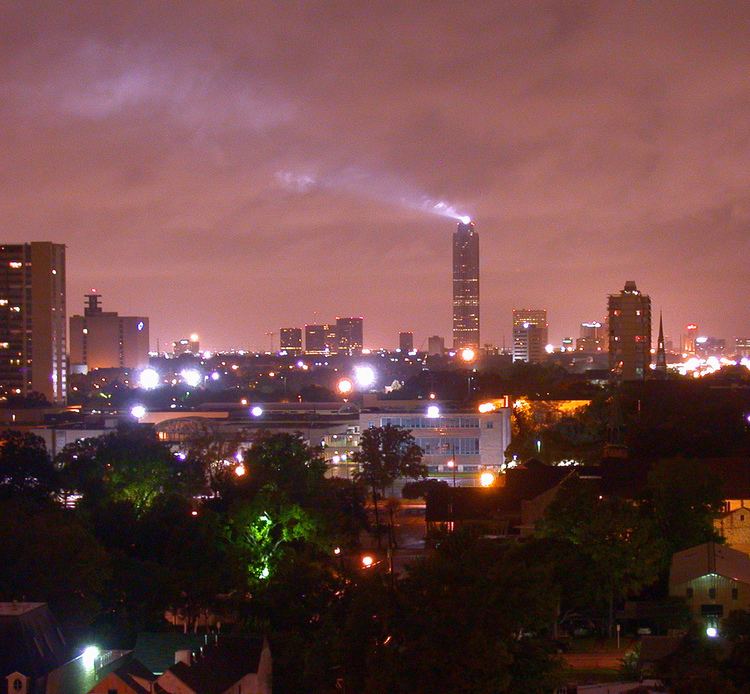Former names Transco Tower Type Office tower Floors 64 | Status Complete Height 275 m Architectural style Post-modern | |
 | ||
Current tenants Williams CompaniesQuanta ServicesRowan CompaniesCadence BancorpHines Interests Address Williams Tower, 2800 Post Oak Blvd, Houston, TX 77056, USA Main contractor J.A. Jones Construction Co Similar Gerald D Hines Waterwall, Bank of America Center, Wells Fargo Plaza, JPMorgan Chase Tower, The Galleria | ||
Houston architecture series the williams tower
The Williams Tower (originally named the Transco Tower) is a 64-story, 1.4-million-square-foot (130×10^3 m2) class A office tower located in the Uptown District of Houston, Texas. The building was designed by New York-based John Burgee Architects with Philip Johnson in association with Houston-based Morris-Aubry Architects (now known as Morris Architects). Construction began in August, 1981 and was completed in December, 1982. The tower is among Houston's most visible buildings and is the 4th-tallest in Texas, the 26th-tallest in the United States, and the 140th-tallest building in the world. The Williams Tower is the tallest building in Houston outside of Downtown Houston, and at the time of its construction was believed to be the world's tallest skyscraper outside of a central business district.
Contents
- Houston architecture series the williams tower
- Williams tower 58th floor
- History
- Major tenants
- Significance
- Features
- References
Williams tower 58th floor
History
Real estate developers Gerald D. Hines Interests hired New York-based John Burgee Architects with Philip Johnson to design the building, in association with Houston-based Morris-Aubry Architects (now known as Morris Architects).
Construction was completed in 1983.
The building was named the Transco Tower after its first major tenant, Transco Energy Co. Transco Energy Co. merged with the Williams Companies in 1995 and in 1999 the name of the building was changed to the Williams Tower.
In December 2002, Ryan John Hartley climbed the tower and jumped from about halfway up, resulting in his death, which was ruled a suicide.
In 2008, Hines REIT Properties LP, an affiliate of Hines Real Estate Investment Trust Inc., purchased the Williams Tower for $271.5 million from Transco Tower Ltd., a partnership consisting of Kuwaiti investors represented by Atlanta-based Fosterlane Management Corp. The building was offered along with a parking garage, a 2.3-acre (0.93 ha) tract across the street from the Williams Tower, and a 48% stake in the Williams Waterwall (now named the Gerald D. Hines Waterwall Park) and the surrounding park; prior to this transaction Hines had already owned the other 52% of the waterwall.
On the morning of September 13, 2008, during Hurricane Ike, the top of the tower was damaged near the rotating beacon and many windows were blown out. The high-rise suffered over $3.5 million in wind damages. Twelve of the 49 elevators were damaged, most by water damage due to roof failures and others due to extreme building sway.
Hines Real Estate Investment Trust Inc. put the Williams Tower up for sale in August 2012, selling it to Invesco Ltd. subsidiary Invesco Advisers Inc. for $412 million in March, 2013.
Major tenants
The building was originally named for its major tenant, Transco Energy corporation, now part of the Williams Companies, the tower's current namesake. Other major tenants include Quanta Services, the Rowan Companies and Cadence Bancorp. The tower also serves as the headquarters for the Hines companies.
Significance
At 64 stories and 909 feet (277 m) above the ground level, the Williams Tower is the tallest building in Houston outside of Downtown Houston. When it was constructed in 1983, it was also the world's tallest skyscraper outside of a city's central business district.
The building was built to function as two separate towers stacked directly on top of one another, one comprising the first forty floors and the other the forty-first to sixty-fourth. The building has separate banks of elevators and lobbies for each of the two building sections. A majority of the bottom 40 floors are occupied by Williams. The remainder of the building is occupied by a variety of tenants.
Williams Tower was named "Skyscraper of the Century" in the December 1999 issue of Texas Monthly magazine. Paul Gapp of the Chicago Tribune said that the building became an "instant classic" when it opened. Paul Goldberger of The New York Times said that the tower gave Post Oak Boulevard "a center, an anchor, which most outtowns lack".
Features
There are six elevators that take tenants to the 51st floor, where they can transfer to other elevators to get to the 49th through 64th floor of the building. There is no public observation deck.
During the night-time hours, the building is defined by a 7,000 watt beacon that sweeps across the sky and can be seen up to 40 miles (65 km) away on a clear night. Topped by such a beacon, the tower hearkens back to the Palmolive Building in Chicago, Illinois. The building, along with its beacon, is a Houston landmark that identifies the Uptown Houston district.
The building is connected to a 10 level, 3,208 car parking garage by a sky bridge. The bridge also connects the building to retail outlets, like the Galleria, and two Federal Aviation Administration-licensed helipads.
In a grass field adjacent to the Williams Tower is the Gerald D. Hines Waterwall Park. Formerly privately owned in common with the tower, the waterwall and park has been owned since 2008 by the Uptown Houston Tax Increment Reinvestment Zone, a non-profit local government corporation.
The Houston Business Journal said that the tower was "designed to be energy efficient". The building received the Environmental Protection Agency's Energy Star label for each year since 2000 in which the building was eligible to receive the award. As of 2009 the building managers are seeking to gain Leadership in Energy and Environmental Design (LEED) certification from the United States Green Building Council.
